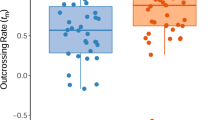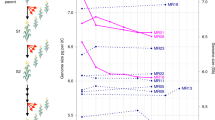Abstract
The evolution of self-fertilization in hermaphrodites is opposed by costs that decrease the value of self progeny relative to that of outcross progeny1,2,3. However, self-fertilization is common in plants4; 20% are highly selfing and 33% are intermediate between selfing and outcrossing5. Darwin6 proposed an adaptive benefit of self-pollination in providing reproductive assurance when outcrossing is impossible6,7,8,9. Moreover, if outcross pollen receipt is inconsistent within or between years, these conditions likewise favour self-pollination10, and this can result in a mixture of self and outcross seed production (mixed mating). Despite wide acceptance, the reproductive assurance hypothesis has lacked the support of complete empirical evidence to show that variable pollination can create both the ecological and genetic conditions favouring self-pollination. We recently showed in Collinsia verna that during periods of infrequent pollinator visits, autonomous self-pollination boosted seed output per flower11, the key ecological condition. Here we show low inbreeding depression and marker-based estimates of selfing, demonstrating that when the pollination environment in wild populations necessitates reproductive assurance, selfing rates increase. We provide a complete demonstration of reproductive assurance under variable pollination environments and mechanistically link reproductive assurance to intermediate selfing rates through mixed mating.
This is a preview of subscription content, access via your institution
Access options
Subscribe to this journal
Receive 51 print issues and online access
$199.00 per year
only $3.90 per issue
Buy this article
- Purchase on Springer Link
- Instant access to full article PDF
Prices may be subject to local taxes which are calculated during checkout


Similar content being viewed by others
References
Jarne, P. & Charlesworth, D. The evolution of the selfing rate in functionally hermaphroditic plants and animals. Annu. Rev. Ecol. Syst. 24, 441–466 (1993)
Lande, R. & Schemske, D. W. I. Genetic models. Evolution 39, 24–40 (1985)
Holsinger, K. E. Mass action models of plant mating systems: the evolutionary stability of mixed mating systems. Am. Nat. 138, 606–622 (1991)
Barrett, S. C. H. The evolution of plant sexual diversity. Nature Rev. Genet. 3, 274–284 (2002)
Vogler, D. W. & Kalisz, S. Sex among the flowers: the distribution of plant mating systems. Evolution 55, 202–204 (2001)
Darwin, C. R. The Effects of Cross and Self-Fertilization in the Vegetable Kingdom Ch. 9 (John Murray, London, 1876)
Stebbins, G. L. Flowering Plants: Evolution Above the Species Level 52 (Belknap, Cambridge, Massachusetts, 1974)
Lloyd, D. G. II. The selection of self-fertilization. Int. J. Plant Sci. 153, 370–380 (1992)
Baker, H. G. Self-compatibility and establishment after ‘long-distance’ dispersal. Evolution 9, 347–348 (1955)
Schoen, D. J. & Brown, A. H. D. Whole- and part-flower self-pollination in Glycine clandestina and G. argyrea and the evolution of autogamy. Evolution 45, 1665–1674 (1991)
Kalisz, S. & Vogler, D. W. Benefits of autonomous selfing under unpredictable pollinator environments. Ecology 84, 2928–2942 (2003)
Cruden, R. W. & Lyon, D. L. in The Evolutionary Ecology of Plants (eds Bock, J. H. & Linhart, Y. B.) 171–207 (Westview, Boulder, Colorado, 1989)
Fausto, J. A. J., Eckhart, E. V. & Geber, M. A. Reproductive assurance and the evolutionary ecology of self-pollination in Clarkia xantiana (Onagraceae). Am. J. Bot. 88, 1794–1800 (2001)
Barrett, S. C. H. Mating strategies in flowering plants: the outcrossing-selfing paradigm and beyond. Phil. Trans. R. Soc. Lond. B 358, 991–1004 (2003)
Lloyd, D. G. & Schoen, D. J. I. Functional dimensions. Int. J. Plant Sci. 153, 358–369 (1992)
Schoen, D. J., Morgan, M. T. & Bataillon, T. How does self-pollination evolve? Inferences from floral ecology and molecular genetic variation. Phil. Trans. R. Soc. Lond. B 351, 1281–1290 (1996)
Holsinger, K. Reproductive systems and evolution in vascular plants. Proc. Natl Acad. Sci. USA 97, 7037–7042 (2000)
Fisher, R. A. Average excess and average effect of a gene substitution. Ann. Eugen. 11, 53–63 (1941)
Herlihy, C. R. & Eckert, C. G. Genetic cost of reproductive assurance in a self-fertilizing plant. Nature 416, 320–323 (2002)
Holsinger, K. E. Inbreeding depression and the evolution of plant mating systems. Trends Ecol. Evol. 6, 307–308 (1991)
Schoen, D. J. & Lloyd, D. G. III. Methods for studying modes and functional aspects of self-fertilization. Int. J. Plant Sci. 153, 381–393 (1992)
Kalisz, S. Fitness consequences of mating system, seed weight and emergence date in a winter annual. Evolution 43, 1263–1272 (2002 1989)
Ritland, K. Multilocus mating system program MLTR 2.2. 〈http://genetics.forestry.ubc.ca/ritland/programs.html〉
Harder, L. D. & Barrett, S. C. H. Mating cost of large floral displays in hermaphrodite plants. Nature 373, 512–515 (1995)
Husband, B. C. & Schemske, D. W. Evolution of the magnitude and timing of inbreeding depression in plants. Evolution 50, 54–70 (1996)
Burd, M. Bateman's principle and plant reproduction: the role of pollen limitation in fruit and seed set. Bot. Rev. 60, 83–139 (1994)
Byers, D. L. & Waller, D. M. Do plant populations purge their genetic load? Effects of population size and mating history on inbreeding depression. Annu. Rev. Ecol. Syst. 30, 479–513 (1999)
Johnston, M. O. Evolution of intermediate selfing rates in plants: pollination ecology versus deleterious mutations. Genetica 102/103, 267–278 (1998)
Barrett, S. C. H., Harder, L. D. & Worley, A. C. The comparative biology of pollination and mating in flowering plants. Phil. Trans. R. Soc. Lond. B 351, 1271–1280 (1996)
Kalisz, S. et al. The mechanism of delayed selfing in Collinsia verna (Scrophulariaceae). Am. J. Bot. 86, 1239–1247 (1999)
Acknowledgements
We thank J. Dunn for technical assistance and J. Dunn, P. Zemrowski, A. Richter, C. Jarzab, H. Lang, R. Brown and A. Mergenthaler for field assistance. D.W. Schemske and S. J. Tonsor provided valuable comments on the manuscript. This work was supported by research grants from the National Science Foundation (USA) and the Research Development Fund of The University of Pittsburgh (S.K.).
Author information
Authors and Affiliations
Corresponding author
Ethics declarations
Competing interests
The authors declare that they have no competing financial interests.
Rights and permissions
About this article
Cite this article
Kalisz, S., Vogler, D. & Hanley, K. Context-dependent autonomous self-fertilization yields reproductive assurance and mixed mating. Nature 430, 884–887 (2004). https://doi.org/10.1038/nature02776
Received:
Accepted:
Issue Date:
DOI: https://doi.org/10.1038/nature02776
This article is cited by
-
Genomic evidence reveals high genetic diversity in a narrowly distributed species and natural hybridization risk with a widespread species in the genus Geodorum
BMC Plant Biology (2023)
-
Autonomous selfing is altered by pollination in delayed-selfing species Gentianopsis paludosa (Gentianaceae)
Brazilian Journal of Botany (2022)
-
A flower with several secretions: anatomy, secretion composition, and functional aspects of the floral secretory structures of Chelonanthus viridiflorus (Helieae—Gentianaceae)
Protoplasma (2022)
-
Pollinator-mediated self-pollination and reproductive assurance in an isolated tree of Magnolia grandiflora L.
Ecological Processes (2020)
-
Do floral traits and the selfing capacity of Mimulus guttatus plastically respond to experimental temperature changes?
Oecologia (2020)
Comments
By submitting a comment you agree to abide by our Terms and Community Guidelines. If you find something abusive or that does not comply with our terms or guidelines please flag it as inappropriate.



